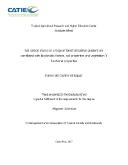| dc.description.abstract | Tropical forests are recognized as the most diverse ecosystems in terms of their wealth and relative abundance. Within these, tropical mountain forests are acknowledged for their key role in the provision of ecosystem services and the serious threat posed by climate change upon them. Of the many ecosystem services offered by tropical forests, the climate regulation service provided by soil makes it the main terrestrial carbon sink and stock.
The response of soil carbon storage to elevation, environmental, soil, and biological conditions has been widely studied. However, factors affecting soil C have been studied separately, leaving aside the high correlation between these factors. This study quantifies the SOC stocks on a trop-ical forest altitudinal gradient (400 – 2900 masl) and aims to answer a key question: when in-terdependent bioclimatic factors, soil properties and vegetation functional properties are all taken into account, which of these sets of predictors best explain variation in SOC?
Total organic C and bulk density were determined to 1 m depth in soil samples from 28 primary forest plots (0.25 ha) distributed over the gradient. Complementary soil properties to 30 cm depth were also measured. Climatic data for each plot was obtained from WorldClim. Commu-nity weighted mean (CWM) values of six functional traits were obtained for 183 tree and palm species, which formed 73-99% of total basal area > 10 cm dbh in all plots.
SOC relations with elevation, bioclimatic factors, soil properties and CWM trait values were evaluated individually through GLMs, using spatial correlation functions and correcting for het-erogeneous variances when this improved model fit. The relative influence of each set of pre-dictors (climate, soil, CWM traits and space as represented by PCNM eigenfunctions) on SOC was then assessed using variance partitioning, including variables selected by Forward Selec-tion in each of the four matrices.
Total soil C stocks to 1 m depth ranged from 6.8 to 43.1 kg m-2. Total SOC and its variance in-creased with elevation (R2=0.64, p<0.0001). Variance partitioning for total SOC and SOC in four depth categories (0-5, 5-20, 20-60 and 60-100 cm) explained 55 to 65% of variation in SOC stocks, though the model was not significant for 5-20 cm soil depth. Forest functional proper-ties, predominantly leaf dry matter content and wood density, had the strongest overall influ-ence on total SOC, followed by bioclimatic and soil variables; the influence of PCNM eigenvalues was relatively low. However, no significant individual fractions were observed.
Elevation and therefore temperature have the expected strong positive correlations with SOC, though no clear patterns were found for soil depth 5-20 cm. CWM WD and LDMC were both positively correlated with SOC. These CWM traits are not correlated with elevation, suggesting that SOC accumulates in stands dominated by species that invest in tough, long-lived leaf and stem tissues.
The lack of significant individual fractions in variation partitioning, however, indicates that SOC is responding to interdependent climate, vegetation and soil factors. The lack of an effect of PCNM eigenvectors suggests that control of SOC is predominantly environmental. Changes in the significant explanatory variables indicate the variation of processes and the different work-ing scales of soil C storage.
To our knowledge, this is the first study to go beyond elevation and determine the influence of a wide range of predictors on SOC in tropical mountain forest ecosystems. Our results strengthen understanding of pattern and process in these ecosystems and should enhance ca-pacity to model the response of their properties to climate change. | es_ES |


